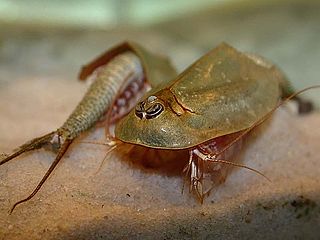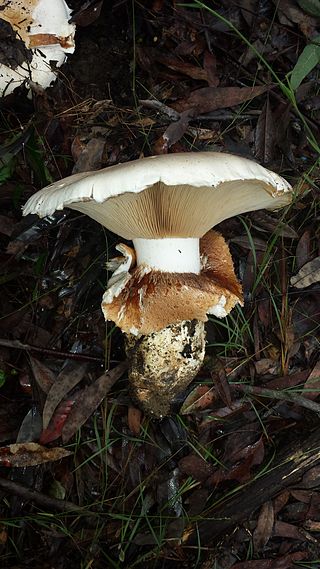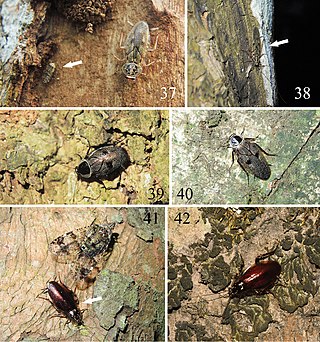
Trypaea australiensis, known as the (marine) yabby or ghost nipper in Australia, or as the one-arm bandit due to their occasional abnormally large arm, and as the Australian ghost shrimp elsewhere, is a common species of mud shrimp in south-eastern Australia, and may be the only extant species in the genus Trypaea. T. australiensis is a popular bait used live or frozen by Australians targeting a range of species. It grows to a length of 6 centimetres (2.4 in) and lives in burrows in mudflats or sandbanks, especially in or near estuaries.

The Australian weasel shark is an uncommon species of ground shark in the family Hemigaleidae. It inhabits shallow waters off northern Australia to a depth of 170 m (560 ft); smaller sharks frequent sand and seagrass habitat and shift to coral reefs as they grow older. A slim, drab species reaching a length of 1.1 m (3.6 ft), it has sickle-shaped fins with dark tips on the second dorsal fin and caudal fin upper lobe. Its upper teeth are broad with strong serrations only on the trailing edge. The lateral line along each side is prominent and exhibits a downward curve below the second dorsal fin.

Metanephrops australiensis, commonly known as Australian scampi or the northwest lobster, is a species of lobster. It is found off the north-west coast of Western Australia, ranging from the city of Eucla to Indonesia. It is prolific near Port Hedland.

Flora Australiensis: a description of the plants of the Australian Territory, more commonly referred to as Flora Australiensis, and also known by its standard abbreviation Fl. Austral., is a seven-volume Flora of Australia published between 1863 and 1878 by George Bentham, with the assistance of Ferdinand von Mueller. It was one of the famous Kew series of colonial floras, and the first flora of any large continental area that had ever been finished. In total the flora included descriptions of 8125 species.
Epichloë australiensis is a systemic and seed-transmissible symbiont of the grass Echinopogon ovatus. It was originally described as a Neotyphodium species but later transferred to the genus Epichloë.

Storckiella is a genus of four recognised species of trees, of the plant family Fabaceae. It belongs to the subfamily Dialioideae. They grow naturally in New Caledonia, Fiji and Australia.

Ovalipes australiensis is a species of crab found in southern Australia. Its range extends from Western Australia to Queensland, including Tasmania. It is fished commercially and recreationally, although it is not as important as the blue swimmer or mud crab.

Semecarpus australiensis, commonly known as the tar tree, native cashew, marking nut, or cedar plum, is a species of tree in the cashew, sumac and mango family Anacardiaceae, native to parts of Melanesia and northern Australia. Contact with the plant can cause serious allergic reactions, a common characteristic of this family.

Triops australiensis, sometimes referred to as a shield shrimp, is an Australian species of the tadpole shrimp Triops.
Hemigaleus is a genus of weasel shark in the family Hemigaleidae. It is characterized by a rounded snout and short gill slits. The mouth is short and broadly arched; the teeth have very short cusps, without toothless spaces at the jaw midlines. The dorsal and pelvic fins, and the lower caudal lobe are strongly falchate. At one time or another, this genus has encompassed up to nine species, but most were eventually split off into other genera. Neogaleus Whitley, 1931 is a junior synonym of this genus.
George Bentham's taxonomic arrangement of Adenanthos was the first comprehensive taxonomic arrangement of that plant genus. It was published in 1870 in his landmark flora of Australia, Flora Australiensis. It would stand for over a hundred years before being superseded by the 1978 arrangement of Ernest Charles Nelson.
Gononemertes australiensis is a parasitic ribbon worm. It lives commensally in the ascidian Pyura pachydermatina found in the sublittoral waters of the New Zealand. G. australiensis was found in specimens of P. pachydermatina collected in Sydney harbor. These worms were found specifically in the atrium of P. pachydermatina. It is dioecious and has several gonads. Each of its gonads produce several oocytes while the male worms carry testes along its parenchyma. Fertilization is external.
Anguillicoloides novaezelandiae is a parasitic nematode worm that lives in the swimbladders of eels, particularly Anguilla australiensis, Anguilla anguilla and Anguilla dieffenbachii. Specimens have been located in Italy and New Zealand. The species is most similar to A. Australiensis. However, it differs from the latter species in the shape of the head end which is bulbously inflated, almost spherical, and followed by a marked neck constriction in A. Australiensis, whereas it is only slightly expanded in A. novaezelandiae. Also, the anterior ovary in A. australiensis females extends anteriorly to about the mid-length of the oesophagus, while it does not reach the end of the oesophagus in A. novaezelandiae. Both species differ in size and form. While the body of A. australiensis is long and relatively slender, that of A. novaezelandiae is much shorter and wider. The shape of the posterior end of the female body is different in these two species.

Prolacertidae is an extinct family of archosauromorph reptiles that lived during the Early Triassic epoch. It was named in 1935 by the British palaeontologist Francis Rex Parrington to include the species Prolacerta broomi of South Africa and Antarctica. In 1979 a second species, Kadimakara australiensis, was described from Australia. Several other genera, such as Macrocnemus, Pamelaria and Prolacertoides, have also been assigned to this family in the past, but these have been placed elsewhere by later studies, leaving Prolacerta and Kadimakara as the only well-supported members.

Podochilus australiensis, commonly known as the native stream orchid, is a species of epiphytic or lithophytic orchid. It has a fern-like appearance with many thin, twisted, glossy green leaves and clusters of up to six dull white or greenish flowers with a green labellum. It grows tropical North Queensland.

Austrocortinarius australiensis, commonly known as the skirt webcap, is a species of mushroom in the family Cortinariaceae which is native to Australia and New Zealand. The white mushrooms appear in autumn and can grow very large, with their caps reaching 30 cm (12 in) in diameter.
Hemisquilla australiensis is a species of mantis shrimp native to Australia and also found in New Zealand.

Selaginella australiensis is a plant in the spikemoss family Selaginellaceae endemic to northeastern Queensland. It grows in rainforest and closed forest from Cooktown to near Mission Beach, including the Atherton Tablelands. It is a low growing and much branched terrestrial plant inhabiting damp shady locations, typically along stream banks.

Allacta is a genus of SE Asian and Australian cockroaches in the subfamily Pseudophyllodromiinae.













